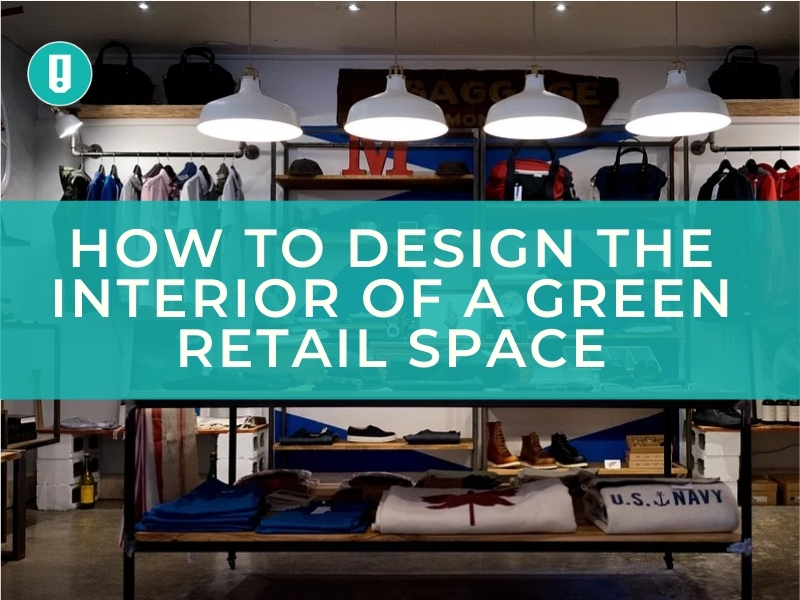Every year, more businesses are joining the fight to save the planet and prioritize sustainability. While LEED certification is an excellent start, it’s only the beginning. If your company values keeping itself green, there are a variety of ways you can incorporate sustainability — including in the design of your retail space.
Fortunately, a lighter carbon footprint doesn’t have to mean a lighter wallet. Green design is good for the environment and your bottom line, especially if you go about it strategically and with plenty of forethought. In addition to looking chic, sustainable interior design has the potential to save your business money in both the short and long run.
Whether you have the capital to hire a sustainable interior designer or are looking for simple projects you or your employees can do in the store, designing the interior of a green retail space is possible on any budget. A more eco-friendly place to work is within your reach, and the positive effects of implementing green interior design will extend far beyond the four walls of your store.
Why Your Business Should Be Environmentally-Friendly
From front-page headlines and lead stories on the nightly news to political debates and protests in cities around the world, growing concern about the state of the environment is at the forefront of many people’s minds. Often prompted by customer demand, many businesses are trending toward sustainability throughout their operations, and along with it, green jobs are popping up and becoming more viable than ever. For businesses on the fence, doing your part to save the planet isn’t the only advantage to taking steps toward sustainability.
In addition to currying favor with customers who wish to support businesses that align with their own values, adopting sustainable practices within your business can also save you money. To start, eco-friendly design practices such as buying items secondhand and refurbishing existing pieces, often cost less than traditional interior design. Likewise, the growing demand for affordable and savvy eco-friendly products means more manufacturers are producing green materials — thus lowering costs.
While eco-friendly design practices will help keep your initial budget in check, outfitting your retail space with energy-efficient and low-carbon technology will help save your business money for years to come, too. By making environmentally-friendly decisions at every step of the design process, your business can qualify for tax allowances and save money on monthly utility bills. Additionally, when your business decides to adopt green practices, it will help contribute to nearly $26 trillion in economic developments.
Top Sustainable Interior Design Tips
With advantages like saving money on monthly utility bills, enhancing your brand, and, of course, minimizing your environmental impact, sustainable interior design is a viable option for many businesses. If your budget allows for it, consider hiring a sustainable interior designer as the most effective way to apply up-to-date practices. A sustainable interior designer can guide you through the process of selecting eco-friendly materials, furniture, furnishings, and equipment.
Even if your business can’t afford to hire a qualified interior designer, it’s still possible to curate a green retail space just with the staff you already have. For example, when selecting materials and furnishings, seek out options that are toxin-free, water/energy-efficient, and which promote good indoor air quality. So as not to negatively impact air quality, choose allergy- and asthma-friendly paints that don’t have VOCs. As for eco-friendly materials, Bio-Glass, which is recycled glass for backsplashes, and veneer cork flooring are just two of the many stylish and affordable options currently on the market.
If, at any point, the many eco-friendly options have you feeling overwhelmed, circle back to one of the simpler sustainable interior design principles: shop mindfully, as well as minimally, both of which stem from living intentionally. Not sure if something is green enough for your store? Consider how it’s made and whether or not it is easily recyclable.
Speaking of recyclable, another cost-efficient way to update your retail space is by transforming existing pieces. Breathe new life into old pieces of furniture by reupholstering or re-staining them. If an item can’t be repurposed and no longer has a place in your new design, consider donating it to charity rather than throwing it away.
Green Design Projects That Will Inspire You
To help you understand how these sustainable interior design tips can be applied in real life, check out other environmentally-conscious projects leading the way for green design. In addition to using a range of natural materials, the firm Perkins + Will designed a Washington D.C. office to include an eco-friendly circadian lighting system that mimics natural daylight. On the other side of the world, the firm Neri & Hu repurposed and renovated existing structures in Yangzhou, China, using a variety of eco-friendly materials such as reclaimed grey brick.
One corporation making waves in green design is the Taiwanese law firm Winkle Partners. Through both small and large improvements within their office, Winkle Partners managed to reduce the firm’s carbon footprint by 57%, according to its 2017 environmental report. The B Corp acknowledged the impressive results were due to a step-by-step process that has been ongoing for 16 years. The changes included the construction of a rooftop garden where employees can grow fruits and vegetables.
Whether you’re overhauling an entire site like Winkle Partners or just revamping your show-room, it’s easy, affordable, and advantageous to incorporate sustainability into your interior design. Implementing sustainable interior design tips and selecting eco-friendly materials will both enhance the look of your store and minimize your business’s impact on the environment.
Jori Hamilton is a freelance writer residing in the Northwestern U.S. She covers a wide range of subjects and with over 8 years of professional writing experience, she has taken a particular interest in topics related to Business, Marketing, SEO Best Practices, and Productivity. You can follow Jori on her Twitter and LinkedIn.







Leave A Comment